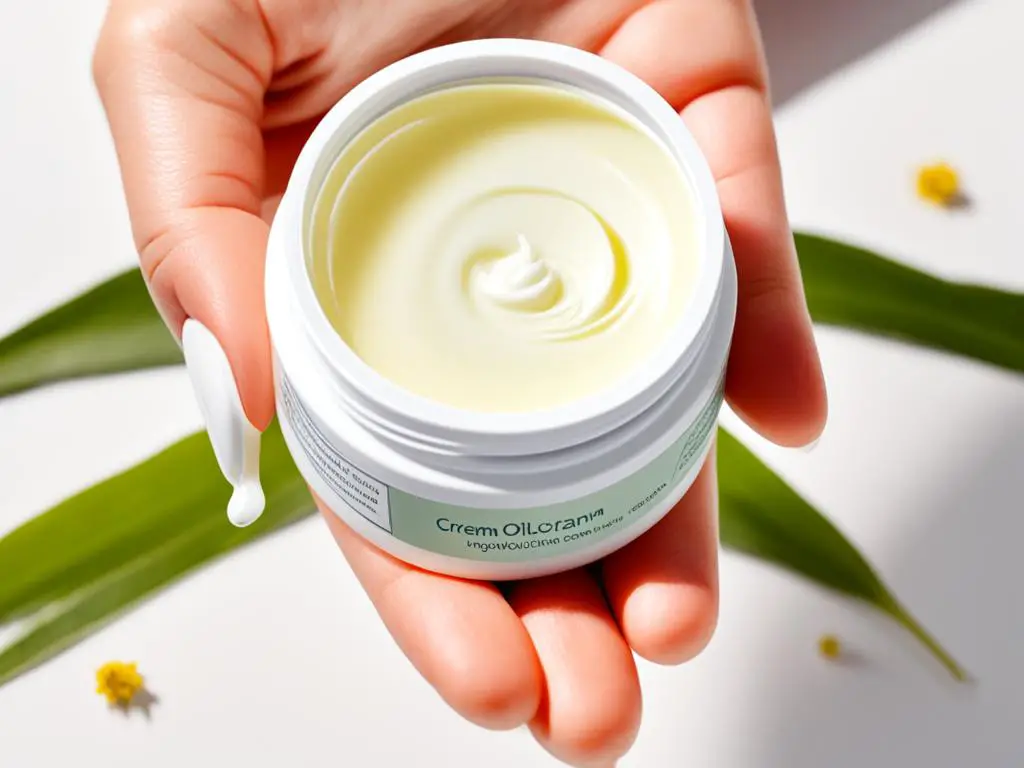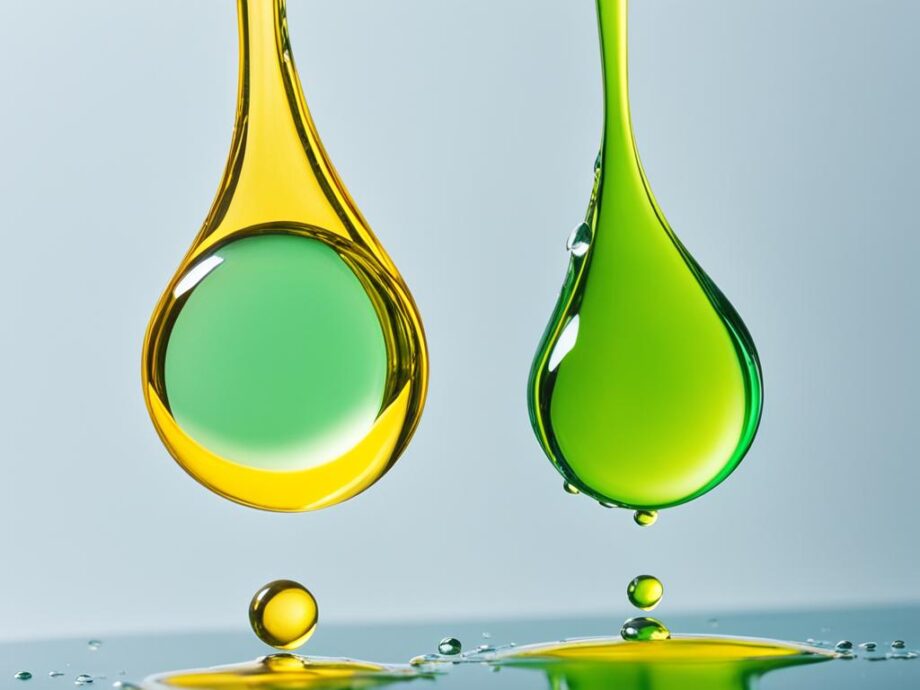Welcome to our comprehensive guide on the benefits of linoleic and oleic acid for skin. If you’re looking to enhance your skincare routine and achieve healthier, radiant skin, you’re in the right place. In this guide, we will explore the specific advantages that these two acids offer and how they can transform the condition of your skin.
- Linoleic and oleic acid are essential fatty acids that are beneficial for skin health.
- Linoleic acid is known for its acne-fighting properties and its ability to reduce inflammation.
- Oleic acid is excellent for moisturizing, nourishing, and protecting the skin.
- Understanding the differences between these two acids can help you choose the one that suits your skincare needs.
- Incorporating linoleic and oleic acid into your skincare routine can lead to healthier, more radiant skin.
Understanding Linoleic Acid
Linoleic acid is an essential fatty acid that plays a crucial role in maintaining healthy skin. It is classified as an omega-6 fatty acid and is part of the polyunsaturated fatty acid group.
So, what makes linoleic acid so important for the skin?
Well, linoleic acid cannot be produced by our bodies, which means it must be obtained through external sources such as diet or skincare products. Once absorbed, it helps reinforce the skin’s natural barrier function, keeping it hydrated and protected.
But what exactly are the benefits of linoleic acid for the skin?
Linoleic acid offers a range of benefits that can improve the overall condition of your skin. Here are some notable ones:
- Promotes Hydration: Linoleic acid helps retain moisture in the skin, preventing dryness and promoting a supple, smooth complexion.
- Prevents Trans-Epidermal Water Loss: By strengthening the skin barrier, linoleic acid helps reduce water loss, keeping the skin hydrated for longer.
- Fights Acne: Linoleic acid possesses anti-inflammatory properties that can help combat acne. It helps regulate sebum production, preventing clogged pores and reducing the occurrence of breakouts.
- Improves Skin Texture: Regular use of linoleic acid can enhance the texture of the skin, minimizing the appearance of roughness and unevenness.
- Reduces Inflammation: Linoleic acid’s anti-inflammatory properties make it an excellent choice for soothing irritated or inflamed skin conditions, such as eczema.
Incorporating linoleic acid into your skincare routine can provide significant benefits for your skin. Whether you have dry, sensitive, or acne-prone skin, this essential fatty acid can make a noticeable difference in the overall health and appearance of your complexion.
Now that you understand the advantages of linoleic acid for the skin, let’s explore another essential fatty acid, oleic acid, and its unique benefits in the next section.

Exploring Oleic Acid
Oleic acid, another fatty acid commonly found in skincare products, offers its own set of benefits for the skin. This natural ingredient is derived from various plant-based sources, such as olive oil and avocado oil. Its unique properties make it a valuable addition to your skincare routine, contributing to a healthy and vibrant complexion.
Oleic acid benefits for skin:
- Moisturizes: Oleic acid has excellent moisturizing properties, helping to seal in moisture and prevent dehydration. It forms a protective barrier on the skin, keeping it hydrated and supple.
- Nourishes: With its high levels of antioxidants and vitamins, oleic acid nourishes and replenishes the skin, promoting a youthful and radiant appearance. It helps in preventing premature signs of aging, such as fine lines and wrinkles.
- Protects: Oleic acid possesses anti-inflammatory and antimicrobial properties, which can help soothe irritated skin and protect it against environmental damage. It helps in reducing redness, soothing inflammation, and promoting overall skin health.
By incorporating skincare products that contain oleic acid, you can experience the numerous benefits it offers. From providing intense hydration to nourishing the skin, oleic acid contributes to achieving a glowing complexion.

The Difference Between Linoleic and Oleic Acid
When it comes to skincare, understanding the difference between linoleic acid and oleic acid is essential. These two acids have distinct molecular structures and can have different effects on the skin. Let’s take a closer look at the characteristics of linoleic acid and oleic acid, helping you determine which acid is better suited for your specific skincare needs.
Linoleic Acid
Linoleic acid is an essential fatty acid that belongs to the omega-6 family. Our bodies cannot produce linoleic acid naturally, so it must be obtained through external sources like skincare products or a balanced diet. This acid is known for its lightweight texture and excellent absorption, making it suitable for various skin types, including oily and acne-prone skin.
Benefits of Linoleic Acid:
- Moisturizes the skin while maintaining a healthy barrier function
- Helps regulate sebum production, reducing acne breakouts
- Reduces inflammation and soothes irritated skin
- Protects the skin against environmental damage, such as UV radiation and pollution
By incorporating linoleic acid into your skincare routine, you can promote healthier, more balanced skin.
Oleic Acid
Oleic acid is another fatty acid commonly found in skincare products. It belongs to the omega-9 family and is known for its moisturizing properties. This acid has a thicker consistency compared to linoleic acid, making it more suitable for dry or mature skin types.
Benefits of Oleic Acid:
- Intensely moisturizes the skin, preventing dryness and flakiness
- Nourishes and strengthens the skin’s natural protective barrier
- Softens fine lines and wrinkles, promoting a more youthful appearance
- Soothes and calms sensitive or irritated skin
Using skincare products containing oleic acid can help combat dryness and maintain a healthy skin barrier.
While both linoleic acid and oleic acid offer valuable benefits to the skin, it’s important to consider your specific skin type and concerns when choosing between the two. Individuals with oily or acne-prone skin may benefit more from linoleic acid, while those with dry or mature skin may find oleic acid more effective. Experimenting with different products and consulting with a skincare professional can help you determine which acid best suits your needs.
Now that you understand the difference between linoleic acid and oleic acid, you can make more informed decisions about incorporating these acids into your skincare routine for healthier, more radiant skin.
Benefits of Linoleic Acid for Skin
Dive deeper into the incredible benefits that linoleic acid offers for your skin. Incorporating linoleic acid into your skincare routine can have a transformative effect on your complexion, promoting a healthier and more radiant appearance.
Fights Acne
One of the standout benefits of linoleic acid is its ability to combat acne. Linoleic acid helps regulate sebum production, the natural oil produced by our skin. When sebum becomes imbalanced, it can clog pores and lead to breakouts. By incorporating linoleic acid into your skincare routine, you can help restore the balance of sebum production, reducing the occurrence of acne.
Reduces Inflammation
Linoleic acid also has anti-inflammatory properties, making it an excellent ingredient for soothing irritated and inflamed skin. Whether you’re dealing with redness, swelling, or sensitivity, linoleic acid can help calm and alleviate these issues, leaving your skin feeling more comfortable and looking healthier.
“Linoleic acid is a game-changer for those with acne-prone and sensitive skin. Its ability to balance oil production while reducing inflammation has made it a staple ingredient in many skincare products.” – Dr. Jessica Rodriguez, Dermatologist
Enhances Skin Barrier Function
Your skin’s barrier function is vital for maintaining hydration and protecting against external aggressors. Linoleic acid plays a crucial role in strengthening and repairing the skin barrier, allowing it to retain moisture more effectively and defend against environmental stressors. Incorporating linoleic acid into your routine can help improve your skin’s overall health and resilience.
Improves Skin Texture
If you’re looking to achieve a smoother and more even skin texture, linoleic acid can be a game-changer. It helps promote the production of ceramides, essential lipids that contribute to the skin’s structure and moisture retention. With increased ceramide levels, your skin will appear plumper and feel softer and more supple to the touch.

As you can see, incorporating linoleic acid into your skincare routine can provide a plethora of benefits for your skin. From fighting acne and reducing inflammation to enhancing the skin barrier and improving texture, linoleic acid is a powerhouse ingredient that can help you achieve a healthier and more radiant complexion.
Benefits of Oleic Acid for Skin
Oleic acid, a monounsaturated fatty acid, has numerous benefits for the skin. Whether you have dry, aging, or sensitive skin, incorporating products containing oleic acid can effectively address your concerns and promote a healthy complexion.
Deep Moisturization
Oleic acid has excellent moisturizing properties, making it an ideal ingredient for dry skin. It helps to replenish the skin’s natural barrier function, preventing moisture loss and leaving your skin smooth and hydrated.
Nourishment and Repair
Rich in antioxidants, oleic acid helps to nourish and repair the skin. It aids in the regeneration of skin cells, promoting a youthful appearance and reducing the visible signs of aging, such as fine lines and wrinkles.
“Incorporating skincare products with oleic acid can help nourish the skin, promoting a youthful and radiant complexion.”
Improves Skin Texture
Oleic acid has a lightweight texture that allows it to penetrate deep into the skin. By softening and smoothing the skin’s texture, it helps to reduce roughness and improve overall skin tone and appearance.
Soothes and Calms
If you have sensitive or irritated skin, oleic acid can provide soothing benefits. It helps to calm inflammation and redness, restoring balance and comfort to the skin.
Enhances Skincare Formulations
Oleic acid is often used as an emollient and carrier oil in skincare products, improving their texture and absorption. It helps other active ingredients penetrate the skin more effectively, optimizing the benefits of your entire skincare routine.
Overall, incorporating products with oleic acid into your skincare routine can lead to nourished, moisturized, and healthier-looking skin.
Choosing Between Linoleic and Oleic Acid
Not sure which acid is right for you? When considering linoleic acid vs oleic acid for skin, it’s important to understand your skin type, concerns, and personal preferences. Here’s a guide to help you make an informed decision:
1. Skin Type
Consider your skin type when choosing between linoleic and oleic acid. If you have oily or acne-prone skin, linoleic acid may be more suitable as it helps regulate sebum production and reduce clogged pores. However, if you have dry or mature skin, oleic acid’s moisturizing properties can provide much-needed hydration and nourishment.
2. Specific Concerns
Identify your specific skincare concerns to determine the right acid for you. Linoleic acid is known for its anti-inflammatory properties, making it beneficial for soothing redness and inflammation caused by conditions like acne and eczema. On the other hand, oleic acid is rich in antioxidants, which can help combat signs of aging and boost collagen production.
3. Personal Preferences
Consider your personal preferences when selecting between linoleic and oleic acid. Some individuals may find that linoleic acid-based products feel lighter and less greasy on the skin, while others may prefer the luxurious texture and moisturizing effects of oleic acid. It’s essential to choose products that you enjoy using and suit your skincare routine.
Remember, everyone’s skin is unique, and what works for others may not necessarily work for you. It’s recommended to conduct a patch test or consult with a dermatologist before incorporating new skincare ingredients into your routine.
Remember, when choosing between linoleic acid and oleic acid for skin, consider your skin type, specific concerns, and personal preferences. Both acids offer benefits that can enhance your skincare routine and promote healthier, radiant skin.
Conclusion
After an in-depth exploration of the benefits of linoleic and oleic acid for skin, it is clear that both acids play a crucial role in achieving and maintaining healthier, more radiant skin. Incorporating these acids into your skincare routine can result in a multitude of positive effects, no matter your skin type or concerns.
Linoleic acid, as an essential fatty acid, offers exceptional benefits for skin health. Its ability to fight acne, reduce inflammation, and promote a balanced complexion makes it a valuable ingredient to look for in skincare products. Additionally, linoleic acid supports the skin’s barrier function, retaining moisture and preventing transepidermal water loss.
On the other hand, oleic acid provides its own set of advantages. Known for its moisturizing properties and ability to nourish and protect the skin, oleic acid is particularly beneficial for dry or aging skin types. It helps to deeply hydrate and rejuvenate, leaving the skin supple and radiant.
Ultimately, the choice between linoleic and oleic acid comes down to personal preference and individual skin needs. Some may find that a combination of both acids works best for them, while others may prefer one over the other. Experimentation and finding the right balance for your skin is key.
Incorporating skincare products containing linoleic and oleic acid can make a significant difference in your skin’s overall health and appearance. Remember to patch test new products and consult with a dermatologist if you have any specific skin concerns. Enjoy the benefits of these powerful acids and embrace your journey to healthier, more radiant skin.
